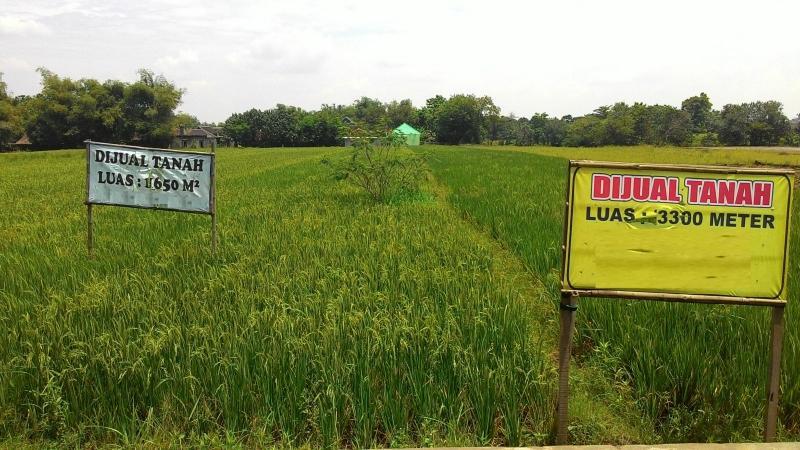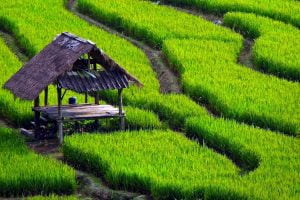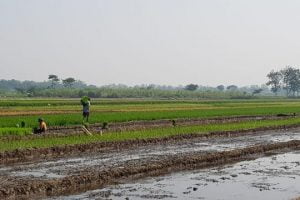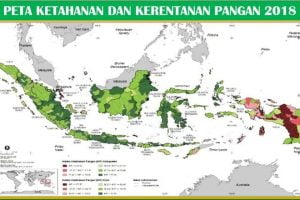
Are young people who will inherit the rice fields from their parents still interested in farming? Are they also still going to keep the rice fields after their parents are passing away? Will they sell the inherited rice fields from their parents or transfer their functions to various non-agricultural activities?
To answer these questions, we conducted a study of young farmers in the Gekbrong District, Cianjur, West Java, Indonesia. The characteristics of the youth who became the research population were: (a) their parents were still present, and had the status of rice field owners, not agricultural worker or land tillers; (b) thus, the young man will be the inheritor of the rice fields of their parents; (c) the young man who will be inheritor of the rice field has a minimum of high school education or its equivalent; and or (c) the young man has already a job outside the agricultural sector, such as being a worker in a garment factory that is spread around Gekbrong and Warungkondang Districts, Cianjur, West Java, Indonesia.
The rice field conditions they will inherit are: (a) located in the hinterland, which does not extend around the Sukabumi-Cianjur-Bandung highway; (c) still intact, not yet undergoing a process of land conversion; but (c) the surrounding rice fields – especially those lying on the side of the highway – have been sold to many investors and converted to various non-agricultural activities, such as being a garment factory, housing, or various other activities; (d) the price of their rice fields has started to rise; and (e) young people are already aware of an increase in the price of land around them.
However, the characteristics of the youth who will be the population of this research are not available at the local Agriculture Service Branch. In other words, the local Branch does not have a list of youth names that have the already- mentioned social characteristics. Thus, this study does not have a sampling frame that will be a reference in determining the list of people who will be sampled, or who will be used as research respondents.
Therefore, to obtain the adequate research samples, we use the snowball sampling technique. For this reason, the sampling process began with a young man we found based on information from a local extension staff. The subsequent samples were obtained from the last young man. And so on, so that the sample size gets bigger, and reaches 100 people – in which the number is sufficient to be analyzed using multiple linear regression models.
Tend to Sell the Heritage Rice Field
The independent variables analyzed in this study were the perceptions of young heirs of rice field to farming practices, both farming practices during planting preparation and planting phase & caring for plants. Another independent variable is the tendency of unwilling to farm. The dependent variable – or the affected variable – that is the focus of analysis is the tendency to sell the inherited rice fields. This research is based on a hypothesis that the youth’s views on farming practices and the unwillingness to farm significantly influence the tendency to sell inherited rice fields. To prove this hypothesis, the research measured and collected data about youth perceptions of farming practices, the tendency of unwilling to farm, and the tendency to sell inherited rice fields. The measurement of these variables adopted four levels of Likert scale. Then we do the testing and analysis using multiple regression analysis. Before carrying out the multiple regression tests, the research carried out various classical tests – such as normality tests – to prove that the data collected from the young heirs of the paddy fields was worth to analyze with the multiple regression model.
Table1. Variables Effect Selling Tendency of Inherited Rice Field
| No. | Perception on farming Practice & Unwilling to Farm | Tendency of Unwilling to Farm | Tendency of Selling Inherited Rice Field | ||
| Coefficient | Sig. | Coefficient | Sig. | ||
| 1. | In Planting Preparation | 0.142 | 0.178 | 0. 223 | 0.023* |
| 2. | In Planting & Plant Caring | 0.001 | 0.996 | 0.260 | 0.029* |
| 3. | In harvesting & Post-harvest | 0.181 | 0.181 | 0.089 | 0.436 |
| 4. | Unwilling to Farm | – | – | 0.424 | 0.000** |
Source: Maman et al. (2018)
The result of regression analysis showed that the dislike of the youth of the farming practice during the planting preparation had a significant effect on the tendency of heritage rice field selling. Likewise their dislike of the farming practice during the planting and caring of the plant is a factor drives the tendency to sell the heritage rice fields. But even more worrying is that the dislike and unwillingness of farming felt by the youth is strongly pushing them to sell the inherited rice fields (Table 1). This trend is very risky for the sustainability of food agriculture. With the lobbies carried out by investors as well as with the lure of high prices, especially if the young man is squeezed by economic problems, then the young heirs of rice fields will easily sell their fields to investors.
Young Farmer Crisis
Methodologically, this study did not have an ability to make generalizations for all prospective young heirs from their parents throughout Indonesia. That is, we cannot say that all young men who own rice fields in Indonesia tend to sell their fields when their parents have died. But this trend is a case that needs to be considered that the future of our agriculture is threatened by the extinction. When there are other jobs outside agriculture, there is a strong tendency that young people will switch to other jobs, and tend to sell rice fields.
This condition is more worrying by paying attention to the tendency of farmers in Tabanan, Bali, who also have a very strong tendency to sell agricultural land; even stronger than the young farmers of Gekbrong, West Java. More than 75% of Tabanan farmers strongly agree and agree that shifting the function of rice fields can solve farmers’ economic problems; that agricultural land is an economic commodity that can be traded; that agricultural land is not able to produce the expected production; that agricultural land is more useful for housing (Table 2).
If it is conducted research in several other areas of the younger generation, it can be expected will produce the same tendency. That is what is happening at the local level, in some areas, at the grassroots level. What happens at the local level, of course, will affect the situation of farmers at the national level. This must be seriously considered.
Table 2. Strong Tendency to Sell the Rice Field
| No. | Indicators | Strongly Agree | Agree | Disagree | Strongly Disagree | ||||
| Res | % | Res | % | Res | % | Res | % | ||
| 1 | Land use change can solve the economic problem of farmer | 17 | 15,18 | 68 | 60,71 | 25 | 22,32 | 1 | 1,79 |
| 2 | Rice field is an economic commodity | 27 | 24,11 | 58 | 51,79 | 21 | 18,75 | 6 | 5,36 |
| 3 | The rice field is unable to produce expected production | 9 | 8,04 | 86 | 76,79 | 16 | 14,29 | 1 | 0,89 |
| 4 | The land for housing is more profitable | 16 | 4,29 | 60 | 53,57 | 31 | 27,68 | 5 | 4,46 |
Source: Processed from, 2014, page 85
Farmer data at the national level shows the same trend. The Central Statistics Agency (BPS), which conducted an inter-survey of agricultural censuses in 2018, showed that the existing farmers in Indonesia are the older farmers who are over 40 years old. It is a very few young people who are interested in farming, only around 0.6% of the total farmers. For more details about the results of the BPS survey, we present it in Table 3.
Table 3. The amount of Farmer in Indonesia by Age Group
| No.
|
Age Group (Year) | The Amount of Family Household | Percentage |
| 1 | ≤ 25 | 191 000 | 0,69 |
| 2 | 25-34 | 2 722 446 | 9,84 |
| 3 | 35-44 | 6 548 105 | 23,65 |
| 4 | 45-54 | 7 841 355 | 28,33 |
| 5 | 55 – 64 | 6 256 083 | 22,60 |
| 6 | ≥ 65 | 4 123 128 | 14,89 |
| Total | 27 682 117 | 100,00 |
Source: The Result of Inter Census Survey (BPS, 2018)
For more clearly, referring to the data presented in Table 3, of the 27 million of farming families in Indonesia in 2018, 14% were aged 65 years or older. In the next ten years the farmer will be in his 75s. Based on humane calculations, in 2028 Indonesia will lose 4 million farmers. In the next 20 years, Indonesia will lose 6 million farmers, and in the next ten years we will lose about 7 million farmers. In short, in the next 30 years, Indonesia will experience a farmers’ crisis, while the position of farmers is needed for food self-sufficiency. Therefore, it is a big task for the Indonesian people to attract young people to become farmers and not to sell the rice fields they inherited from their parents.***
Reference
Central Statistical Agency, 2018, The Result of Inter-Census Agricultural Survey 2018.
Dwipradnyana, I Made Mahadi. “Faktor-Faktor Yang Mempengaruhi Konversi Lahan Pertanian Dan Pengaruhnya Bagi Kesejahteraan Petani: Studi Kasus Di Subak Jadi, Kediri, Tabanan.” Udayana University, 2014.
- Maman et al., (2018), “From Single to Dual System: Initiating the Model of Rice Field Management to Optimize Staple Food Availability,” Journal of Engineering and Applied Sciences Vol 13(21), 9259-9268.



